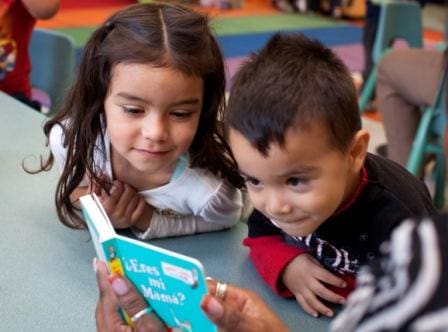
7 Facts About English Language Learners … & How They’re Awesome!
1.
27% of U.S. children under age 6 come from homes where at least one parent speaks a language other than English.1
2.
Relative to other U.S. children, dual language learners/English language learners are far more likely to live in poverty and in two-parent families with low levels of education.2
3.
71% of school-age children who are dual language learners come from homes where Spanish is spoken.3
4
Maintenance of children’s home language has important cultural value in families and facilitates the development of closer relationships between children and their caregivers and peers.4
5.
Research indicates that strong home language skills help build and transfer English language skills.5
6.
Individuals who have continuous, high-quality exposure to more than one language from a young age have… more connectivity in regions of the brain associated with language processing, as well as memory, attention and other executive functions.6
7.
[They] are likely to reap benefits in cognitive, social, and emotional development and may also be protected from brain decline at older ages. 2

Learning English as a second language can be a very challenging journey for children, educators and caregivers. The First Book Marketplace is a resource hub for those working with English Language Learners and their families. We offer a variety of books in Spanish, as well as Spanish/English bilingual books (including Macmillan’s new Brown Bear, Brown Bear, What Do You See? board book – watch our staff read this title aloud here), and many free tip sheets for you to share with parents to help families enjoy stories together both in their home language and English.
Citations
1Capps, R., Fix, M., Ost, J., Reardon-Anderson, J. & Passel, J. (2004). The Health and Well-Being of Young Children of Immigrants. Washington, DC: Urban Institute.
2Le Menestrel, Suzanne & Takanishi, Ruby. (2017). Promoting the Educational Success of Children and Youth Learning English: Promising Futures. Washington, DC: The National Academic Press.
3Ruiz Soto, A.G., Hokker, S. & Batalova, J. (2015). Top Languages Spoken by English Language Learners Nationally and by State. Washington, DC: Migration Policy Institute.
4August, D. & Shanahan, T. (2006). Developing literacy in second-language learners: Report of the National Literacy Panel on language-minority children and youth. Mahwah, NJ: Erlbaum and Halle, T.G. Whaittaker, J.V., Zepeda, M., Rothenberg, L., Anderson, R., Daneri, P., & Buysse, V. (2014). The social-emotional development of dual language learners: Looking back at existing research and moving forward with purpose. Early Childhood Research Quarterly, 29(4), 734-749.
5Carlo, M., Barr, C., August, D., Calderon, M. & Artzi, L. (2014). Language of instruction as moderator for transfer of reading comprehension skills among Spanish-speaking English language learners. Bilingual Research Journal, 37(3), 287-310.6Kaiser, A., Eppenberger, S., Smieskova, R., Borgwardt, S., Keuenzli, E., Radue, E., and Bendfeldt, K. (2015). Age of second language acquisition in multilinguals has an impact on grey matter volume in language-associated brain areas. Name: Frontiers in Psychology, 6, 638.
